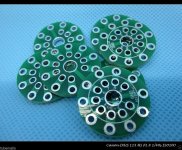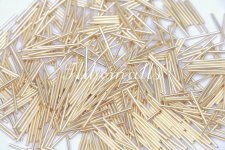Just wondering....does anyone know why the 7199 tube went out of production decades ago? Over 350,000 Dynaco ST70s were built that use the tube...its not like there was no market for them.
Were they expensive or difficult to make? With all the other preamp tubes still on the market I just find it strange that China hasn't made one yet.
Were they expensive or difficult to make? With all the other preamp tubes still on the market I just find it strange that China hasn't made one yet.

Last edited:
The Russians did make them and then stopped. Please keep the fact that tube HIFI is a niche market. Tube builders, in the main, make their money from musical instrument amps. AFAIK, this sort of pentode/triode is not part of instrument amp designs.
All the suitable pentode/triode types are out of production and stocks are dwindling. Perhaps when stocks have become essentially non-existent, New Sensor will reintroduce production of a single type.
If you own equipment that employs 7199s, take whatever action is appropriate to using available tubes. In the case of the Dyna ST70, that means (IMO) a new driver board, of which there are numerous possibilities. FWIW, my preferred ST70 driver board is the Triode Electronics variant populated with 2X EF86s and an ECC99. The OEM topology is retained, while better active elements are employed.
All the suitable pentode/triode types are out of production and stocks are dwindling. Perhaps when stocks have become essentially non-existent, New Sensor will reintroduce production of a single type.
If you own equipment that employs 7199s, take whatever action is appropriate to using available tubes. In the case of the Dyna ST70, that means (IMO) a new driver board, of which there are numerous possibilities. FWIW, my preferred ST70 driver board is the Triode Electronics variant populated with 2X EF86s and an ECC99. The OEM topology is retained, while better active elements are employed.
Or re-wire for 6au8 ...
Not on a stock ST70, with its shitty phenolic substrate driver PCB. Wreckage is all too likely. I'd also be afraid of putting adapters in, so any of the 6GH8/6U8/6BL8 bunch function. JMO, get the garbage out of there and the FR4 substrate PCB of your choice in.
A few other "rewire" subs: 6AN8, 6BH8, 6EA8, EF86, 6AU8, 6CX8, 6KD8, 7258, 7687
7199 seems to have been designed originally for cheap 2 tube portable phonographs. Instead of just subbing in for it, why not put something better in place, like a 6F12P. Could even do a Triode/Pentode LTP. Some board re-design needed obviously.
7199 seems to have been designed originally for cheap 2 tube portable phonographs. Instead of just subbing in for it, why not put something better in place, like a 6F12P. Could even do a Triode/Pentode LTP. Some board re-design needed obviously.
Not on a stock ST70, with its shitty phenolic substrate driver PCB. Wreckage is all too likely. I'd also be afraid of putting adapters in, so any of the 6GH8/6U8/6BL8 bunch function. JMO, get the garbage out of there and the FR4 substrate PCB of your choice in.
Specific replacement for ST70 was not the original question, though I do very much agree with your assessment of the original ST70 driver PCB. Also, a different driver for ST70 is a GREAT idea, but can you still call it an ST70 after that? Maybe we don't need to start this discussion (again)....
From what I can tell, the 6AU8 is pretty much electrically equivalent to 7199, just has a different pin-out. Current prices puts it in the "affordable" range too. Oddball triode/pentode envelopes are interesting.
Last edited:
7199s were even hard to find in the early 90s, when I got my first Dynaco 70 and later, a pair of monoblock Mark IVs.
Back then I wired them - but PCB lead cutting and wires - with 6U8As.
The last Dynaco 70 I rebuilt? I used the EF86/12AU7 driver board from Triode Electronics.
Back then I wired them - but PCB lead cutting and wires - with 6U8As.
The last Dynaco 70 I rebuilt? I used the EF86/12AU7 driver board from Triode Electronics.
Make any tube into a 7199 base: (pics)
6AU8 is interesting, since it uses the 9DX base. Over 20 other tube types use that base too, including some frame grid types. Some resistor changes likely needed to try them however.
6AU8 is interesting, since it uses the 9DX base. Over 20 other tube types use that base too, including some frame grid types. Some resistor changes likely needed to try them however.
Attachments
...why the 7199 tube went out of production decades ago? Over 350,000 Dynaco ST70s were built that use the tube......
And they last "forever" in the light duty of a ST70. Apparently not 3 decades, but in the first few years the few replacements did not make a dent in the existing inventory.
And all tubes were going out of style. Transistors were the in thing. Akai and PhaseLinear were selling tranny-amps hand over fist. All those tube amps were going into closets and would never come out again.
It's like making parts for a 1964 Mustang. Hip once, but got to be an old junker. Daddy got into a 1979 ThunderBird. All the kids were zooming in Mustang IIs. (Ironically, today you can buy ANY part for a 1960s Mustang new-made... but car-parts is easier than vacuum tubes.)
This is an effect of high catode <> filament voltage, and as the filament is shared with the pentode you cannot elevate the filament as needed. To have two different tubes inside the glass is not and have never been an asset, it is a beancounters compromize.Sometimes the 7199 developed filament to (triode) cathode leakage.
That makes some 2nd harmonic distortion which is only partly cancelled out by the negative feedback.
The Dyna Stereo 70 has two center tapped 6.3V filament secondaries with the center taps connected to two ceramic capacitors to ground. Each secondary powers two EL34 and one 7199. The 6.3V is floating to whatever voltage it lands at. Murphy's law says it will float to where it can do the most damage to the 7199 triode cathode to filament 'insulation'.
Replacing the 7199 with a 6AU8, 6AN8, or other "equivalent" triode/pentode pair is not going to solve the cathode to filament leakage problem.
In addition, the pentodes do not have the same plate resistance, rp, so the dominant pole RC series network that connects to from the pentode plate to ground should be recalculated and changed (one network for each channel).
Instead, fix the cathode to filament leakage problem: "From" "Sound Practices" Issue 10: Connect the center taps to a resistor divider; 390k 1 Watt resistor from the output stage B+, and the other end of the 390k to a 82k 1/2 Watt resistor, and the other end of the 82k to ground. Parallel the 82k with a 1uF 200V cap. Problem solved, whatever triode/pentode pair you choose to use.
Replacing the 7199 with a 6AU8, 6AN8, or other "equivalent" triode/pentode pair is not going to solve the cathode to filament leakage problem.
In addition, the pentodes do not have the same plate resistance, rp, so the dominant pole RC series network that connects to from the pentode plate to ground should be recalculated and changed (one network for each channel).
Instead, fix the cathode to filament leakage problem: "From" "Sound Practices" Issue 10: Connect the center taps to a resistor divider; 390k 1 Watt resistor from the output stage B+, and the other end of the 390k to a 82k 1/2 Watt resistor, and the other end of the 82k to ground. Parallel the 82k with a 1uF 200V cap. Problem solved, whatever triode/pentode pair you choose to use.
DF96,
At my work cubicle I posted a number of "Notices".
Some customers were measuring fast rise, high current systems. In some cases, they had long return wires to ground. They measured at the 'top' of the return wire, and wondered why they had up to hundreds of volts there (and they wondered why their circuits were not working properly).
My favorite notice I posted at my cubicle was: "Grounds are Commonly Mis-understood"
I guess they did not subscribe to 'Inductive' Reasoning.
At my work cubicle I posted a number of "Notices".
Some customers were measuring fast rise, high current systems. In some cases, they had long return wires to ground. They measured at the 'top' of the return wire, and wondered why they had up to hundreds of volts there (and they wondered why their circuits were not working properly).
My favorite notice I posted at my cubicle was: "Grounds are Commonly Mis-understood"
I guess they did not subscribe to 'Inductive' Reasoning.
Problem not solved. What happens is that the penthode section will haveThe Dyna Stereo 70 has two center tapped 6.3V filament secondaries with the center taps connected to two ceramic capacitors to ground. Each secondary powers two EL34 and one 7199. The 6.3V is floating to whatever voltage it lands at. Murphy's law says it will float to where it can do the most damage to the 7199 triode cathode to filament 'insulation'.
Replacing the 7199 with a 6AU8, 6AN8, or other "equivalent" triode/pentode pair is not going to solve the cathode to filament leakage problem.
In addition, the pentodes do not have the same plate resistance, rp, so the dominant pole RC series network that connects to from the pentode plate to ground should be recalculated and changed (one network for each channel).
Instead, fix the cathode to filament leakage problem: "From" "Sound Practices" Issue 10: Connect the center taps to a resistor divider; 390k 1 Watt resistor from the output stage B+, and the other end of the 390k to a 82k 1/2 Watt resistor, and the other end of the 82k to ground. Parallel the 82k with a 1uF 200V cap. Problem solved, whatever triode/pentode pair you choose to use.
a larger filemant<>cathode voltage. This is one of the problems with
"combined tubes" like 7199 / 6u8/ etc.
The above suggestion reduces the filament<>cathode voltage for the triod section but at the cost of the penthode and the powertubes ( in the st70 case) I call the above suggestion a band-aid, not useless, it's better then nothing but no solution.
Unfortunately, I have an old HP FM stereo generator I would like to restore. It's full of 7199 tubes, and 6EU7 as well. The 6EU7 was an excellent choice back then, but it is a killer for my pocket book today. The 6EU7 was an improved 12AX7A with a different pinout for reduced hum pickup. It also had a shield between the two sections like the 6922 does. What's not to like about an improved 12AX7A?
For the 7199, I have no problems at all rewiring for something else.
-Chris
For the 7199, I have no problems at all rewiring for something else.
-Chris
- Status
- This old topic is closed. If you want to reopen this topic, contact a moderator using the "Report Post" button.
- Home
- Amplifiers
- Tubes / Valves
- Why no 7199s anymore? Anyone know?

